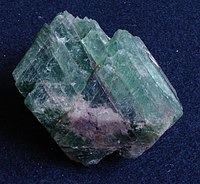
Photo from wikipedia
The dendrite problem of zinc anodes leads to poor cyclic life and safety hazards, which seriously hinders the development of aqueous zinc-ion batteries (ZIBs). Herein, we propose a new strategy… Click to show full abstract
The dendrite problem of zinc anodes leads to poor cyclic life and safety hazards, which seriously hinders the development of aqueous zinc-ion batteries (ZIBs). Herein, we propose a new strategy to develop textured zinc anodes with preferential orientation (002) by cleavage fracture along the interface of zinc foil and low lattice mismatched CuZn5 alloy, which is highly reversible, long-life, and dendrite-free. The sequentially distributed (002) cleavage texture has high surface energy and strong binding energy with zinc atoms, which can significantly reduce the nucleation barrier of zinc and facilitate uniform zinc deposition. Furthermore, the cleavage texture of (002) planes promotes the epitaxial growth of zinc and prevents the dendrite formation. As a result, the zinc anode with the (002) cleavage plane (ZCP(002)) possesses an ultralong lifetime of about 2500 h in 1 mA cm-2 and 1 mA h cm-2 of symmetric battery and a high average Coulombic efficiency (99.7%) over 925 cycles in ZCP(002)|Cu asymmetric cells. This work provides new insights into modifying metal anodes from the perspective of crystallographic orientation and optimizing zinc anodes for the large-scale application of ZIBs.
Journal Title: ACS applied materials & interfaces
Year Published: 2022
Link to full text (if available)
Share on Social Media: Sign Up to like & get
recommendations!